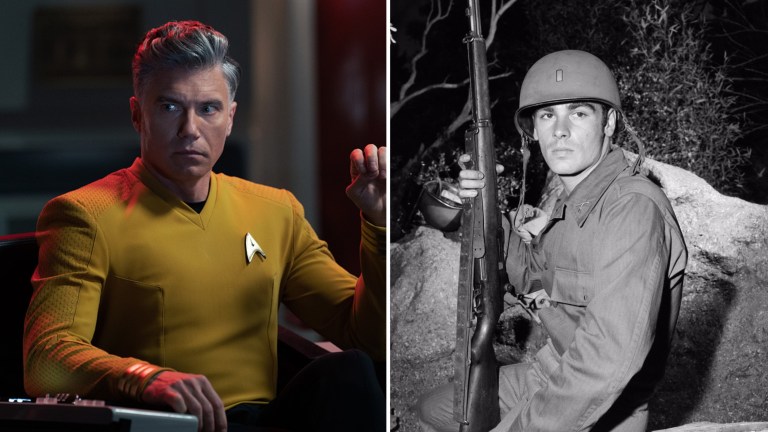Why Star Trek: Strange New Worlds Owes a Big Debt to The Twilight Zone
Strange New Worlds reminds us how the histories of Star Trek and The Twilight Zone have long been intertwined.

This Star Trek article contains spoilers.
In Act 4, Scene 1 of The Merchant of Venice by William Shakespeare, the heroine Portia, posing as a male lawyer, begs Shylock the moneylender to spare her love’s friend the “pound of flesh” that he is owed. Her speech goes:
“The quality of mercy is not strained.
It droppeth as the gentle rain from heaven
Upon the place beneath. It is twice blest:
It blesseth him that gives and him that takes.
‘Tis mightiest in the mightiest; it becomes
The thronèd monarch better than his crown.”
It is the quote referenced by the title of Star Trek: Strange New Worlds’ finale, “A Quality of Mercy,” demonstrating, aside from anything else, that sometimes what you learn in your degree can be relevant to your job. The use of the quote tells us about Pike’s character, what sort of commander he is, and what fuels the decisions he makes about his future. It also nicely counters “The Balance of Terror,” the episode that “A Quality of Mercy” is an alt-history remake of.
But it’s also a misquote. “A Quality of Mercy,” not “The Quality of Mercy” like in the line from the play, and that isn’t a mistake.
“A Quality of Mercy” was also the title of the 80th episode of the classic sci-fi anthology series, The Twilight Zone, in which a bloodthirsty American soldier on the eve of the end of war in the Pacific Theater finds himself quantum leap into the body of a soldier on the opposing side. Indeed, Quantum Leap’s Al, Dean Stockwell, appears in the episode, alongside another actor named Leonard Nimoy. But the connection between Star Trek: Strange New Worlds and The Twilight Zone runs much deeper than that.
This One Has A Twist
Strange New Worlds has not been shy about its debt to The Twilight Zone. From very early on in its production process, show creator Akiva Goldman said that this would be a more episodic Star Trek.
“And that allows us to do something that The Original Series is quite good at, to give you slightly different tones. And to give you—for lack of a better word—hidden morals of the story,” Goldman said. “Like an O. Henry turn, like a Twilight Zone that gives you a kind of pop that really is the province of episodic storytelling.”
From the start, Strange New Worlds has paid homage to classic Trek, but more importantly, it has paid homage to the classic science fiction that inspired the original Star Trek. The pilot begins with Captain Pike watching The Day The Earth Stood Still, right before he flies off into space and basically re-enacts the film’s plot.
The episode “Lift Us Where Suffering Cannot Reach,” the most Twilight Zone-ish of all the episodes, is a straight-up uncredited retelling of Ursula K. Le Guin’s classic short story, “The Ones Who Walk Away from Omelas.” “All Those Who Wander” picks an even more well-known source material — Alien (and not for the first time in Trek history). Kingsley Amis once pointed to critics complaining that Alien’s premise was “science fiction plot no. 3,” arguing that “part of its glory was that it came near being plot no. 1”- and that is why it’s here.
Part of the idea that drove the original Star Trek series, and The Twilight Zone, was to take the concepts and stories that had developed a passionate following in paperbacks and magazines and bring those narratives to the screen. Strange New Worlds’ first season, then, functions as a kind of taster plate of the genre, and so it’s not surprising it looked to The Twilight Zone for its cues.
But the history between the two franchises goes back much further than that.
The Twilight Zone and the Final Frontier
We have talked before about the pivotal role Lucille Ball played in the birth of Star Trek, but The Twilight Zone also started life as a pilot in CBS’s Westinghouse Desilu Playhouse anthology series, with Lucille Ball’s business partner and then-husband playing Rod Serling’s role of providing the opening and concluding narration of the episode.
The Twilight Zone paved the way for more than just bringing science fiction to the small screen. It also pioneered Star Trek’s technique of using aliens with antennae and funny hats to talk about the kind of real-world political issues that advertisers and network heads alike wanted no part of.
As well as Leonard Nimoy, The Twilight Zone also gave roles to actors including William Shatner, George Takei (who also appeared in the recent Jordan Peele-fronted reboot), James Doohan, Arlene Martel (the original actor to play Spock’s fiancée, T’Pring), and Susan Oliver, who played the stranded human Captain Pike met in the original Star Trek pilot (and who the character is destined to end up with in “The Menagerie.”)
There was also plenty of talent cross-pollination behind the camera, with Jerome Bixby writing Star Trek’s “Mirror, Mirror,” “By Any Other Name,” “Day of the Dove,” and “Requiem for Methuselah,” as well as The Twilight Zone episode “It’s A Good Life” (which had a premise very similar to Star Trek’s “Charlie X”). “The Man Trap,” one of about three episodes to have a claim on being the first-ever Star Trek episode (depending on how you count) was written by George Clayton Johnson. It was an episode about a doomed, predatory shape-shifter, similar to “The Four of Us Are Dying,” which is based on a story written by Johnson.
Richard Matheson was a science fiction heavyweight in his own right, and crewed the typewriter behind Star Trek’s “The Enemy Within,” as well as Twilight Zone episodes “And When the Sky Was Opened,” “Third from the Sun,” “The Last Flight,” and the classic, William Shatner-starring, “Nightmare at 20,000 Feet.”
And that is just a taster.
Episode ideas from The Twilight Zone have also been frequently echoed in Star Trek, sometimes as parallel evolution, sometimes as a direct influence, and sometimes because the writers were all stealing from the same places.
Matheson’s “The Last Flight” sees a fighter pilot from the Great War land on an airstrip in 1959, then decide to return to the past, even though it will doom him. Star Trek: The Next Generation’s “Yesterday’s Enterprise” gives us the same plot with starships instead of biplanes. Also from The Next Generation, we have the episode “Allegiance,” where three unrelated characters attempt to escape a mysterious, featureless prison, not unlike the setting of the Twilight Zone episode “Five Characters in Search of an Exit” (and later the 1997 movie Cube).
Meanwhile, the classic Star Trek episode “The Apple” sees primitive aliens worshipping a god they don’t realize is only a computer. “The Old Man in the Cave” from The Twilight Zone gives us post-apocalyptic townspeople following the same arc, but with a somewhat more pessimistic outcome. Kirk reveals the truth allowing the aliens to find self-determination (Prime Directive, Slime Directive). When the same truth is revealed to the post-apocalyptic townspeople they take it as an opportunity to eat all the contaminated food the computer had warned them against, dying immediately.
An Anthology Procedural
As we’ve argued before, Star Trek’s innovation was to take the anthology-like tales of The Twilight Zone and give us a set of recurring characters (beyond Serling’s suave narrator) to travel with us through those stories.
It is probably not a coincidence that Strange New Worlds came about not long after a huge resurgence in anthology series like Black Mirror and Love, Death & Robots proved there was an appetite for a classic brand of old-school science fiction stories.
This brings us back to “A Quality of Mercy.” The title of the story is more than just a callback to one of Strange New Worlds’ science fiction grandparents. Like the original Twilight Zone story, the Strange New Worlds finale takes a soldier and offers him a different perspective, which informs the choices he makes going forward. In this case, the decision is that the crisis needs someone who, ironically, has a much less Star Trek solution to the situation than Pike.
It is a fitting tribute to Strange New Worlds’ heritage, both in the Trek franchise and beyond. Now that the show has served up this “taster plate” of what anthology sci-fi can do (we haven’t had room here to go into body swap “shenanigans” or the “mysterious cloud makes everyone dress medieval” episode, but these are also distinct and vintage Star Trek flavors), and season 2 has wrapped, the question is what will it serve up next?
I hope the show will continue to steal from the best. A planet based on Kurt Vonnegut’s “Harrison Bergeron” perhaps, or an isolated space station where alien cyber monks are engaged in work that is legally distinct from the plot of Arthur C. Clarke’s story “The Nine Billion Names of God.”
Maybe they could even start to delve into the work of modern and more diverse writers.
